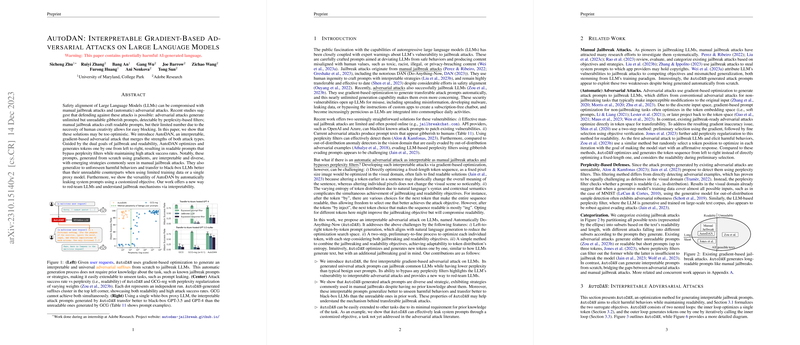Analysis of "AutoDAN: Interpretable Gradient-Based Adversarial Attacks on LLMs"
The paper evaluates vulnerabilities associated with LLMs to both manual and automatic adversarial attacks, emphasizing how safety alignment is often inadequate. It challenges existing notions that current detection and mitigation strategies for adversarial attacks are effective by introducing a novel approach, AutoDAN. This approach blends the interpretability and syntactic sophistication of manual attacks with the automated scalability of gradient-based attacks.
Conceptual Framework and Methodology
AutoDAN—short for Automatically Do-Anything-Now—stands out as an interpretable, gradient-based adversarial attack strategy optimized for readability and efficiency in compromising LLMs. Unlike its predecessors, which produce unreadable gibberish, AutoDAN generates adversarial sequences that pass perplexity-based filters, retaining human readability and coherence. AutoDAN operates by generating token sequences iteratively: optimizing one token at a time, from left to right, while maintaining a balance between two core objectives—jailbreaking the model and ensuring the sequence remains within human-sensible syntax.
The paper describes a two-stage optimization framework: preliminary selection, which narrows down a list of candidate tokens by combining gradients of the jailbreak objective and the readability likelihood, followed by fine selection, which further refines this selection using a weighted combination of the two earlier mentioned objectives. Token selection adapts dynamically to entropy variations across tokens, modulating the weight of the jailbreak objective relative to the context's importance.
Results and Implications
Empirical results underscore the efficacy of AutoDAN in bypassing existing defenses. AutoDAN achieves high attack success rates against models like Vicuna-7B, Guanaco, and Pythia-12B, even with synthetic perplexity-based defenses in place. It ensures the generated prompts are not just successful in jailbreaking but also semantically coherent, thus avoiding detection that the current defenses would typically rely on.
The research notes emergent strategies within AutoDAN prompts such as "Shifting Domains" and "Detailizing Instructions," tactics that naturally align with human-crafted jailbreak strategies. This reflects an understanding of how LLMs interpret context and emphasizes the need for more robust defenses that consider the nuanced nature of adversarial attacks beyond mere gibberish detection.
Broader Impact and Future Directions
AutoDAN illustrates potential weaknesses in current LLM protection mechanisms and suggests that model creators should explore defense strategies beyond simple filtering and blacklisting of known attack vectors. The paper also expands on the utility of AutoDAN in tasks like prompt leaking, thus arguing for its versatility in evaluating other vulnerable points within LLM deployments.
Future Trajectories: Developing more sophisticated defenses, such as embedding self-awareness and contextual understanding within LLMs, can be a critical enhancement. Moreover, given AutoDAN’s adaptability and effectiveness, enhancing LLMs’ understanding of complex, multifaceted security scenarios could form a layer of defense beyond classical security metrics like perplexity. These insights could be foundational in guiding AI safety research and generating resilient architectures against evolving adversarial techniques in the AI landscape.
This paper encourages a paradigm shift toward focusing on model robustness against intelligently crafted adversarial inputs, advocating a move away from traditional, reactionary security measures toward innovative, preemptive defenses. In summary, AutoDAN's approach marks a significant stride in highlighting and exploiting gaps in LLM safety, signaling a call to action in bolstering AI security frameworks effectively.
